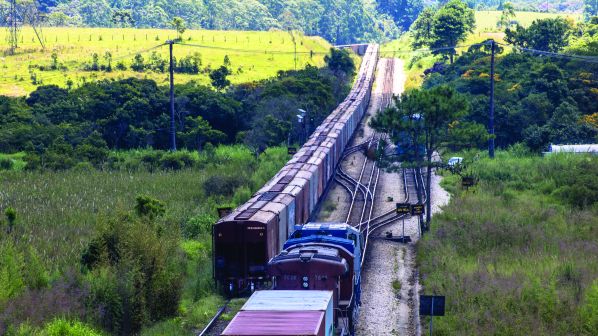THE Brazilian minister of infrastructure, Mr Tarcísio Gomes de Freitas, authorised the Reais 50bn ($US 8.877bn) construction of nine railways in the country on December 9, which will expand the network by 3506km.
The plans are part of the of Pro Trilhos Program, which was created through the new Legal Framework for Railways, and aims to expand the national network based on private investment.
The railways are located in the states of São Paulo, Mato Grosso do Sul, Paraná, Maranhão, Minas Gerais, Espírito Santo, Piauí and Pernambuco. Contracts for the construction work were signed by Bracell, Ferroeste, Grão Pará, Macro Desenvolvimento, Petrocity and Planalto Piauí Participações.
With the exception of Ferroeste, all the businesses are new operators. These companies were all originally linked to private use terminals in ports or to the cargo originators themselves.
Under the plans, the companies will construct and operate:
- Bracell: Lençóis Paulistas: A Reais 40m, 4.29km line connecting the company's factory in Lençóis Paulistas to the Port of Santos. This will transport 1 million tonnes of eucalyptus logs per year
- Bracell: Lençóis Paulistas - Pederneiras: A Reais 200m, 19.5km line connecting Lençóis Paulistas and the Pederneiras rail network, heading towards the Port of Santos. The objective is to transport around 1.7 million tonnes of pulp per year
- Ferroeste: Cascavel - Chapecó: A Reais 6.4bn, 286km line that will carry raw material, mainly corn, to the animal husbandry and food production industries based in the west of Santa Catarina
- Ferroeste: Maracaju - Dourados: A Reais 1.2bn, 76km line that will connect Maracaju, the largest grain producer in Mato Grosso, and Dourados, where plants capable of absorbing an important part of the state’s soy and corn production are installed
- Ferroeste: Cascavel - Foz do Iguaçu: A Reais 3.1bn, 166km line for international freight transport towards the Port of Paranaguá
- Grão Pará: Alcântara to Açailândia: A Reais 5.2bn, 520km railway that will that will carry an estimated 50 million tonnes of freight per year including solid bulk, liquid bulk and containers. The line will connect the Alcântara Port Terminal to the municipality of Açailândia, an industrial hub for pig iron. There will be a connection with the North South Railroad (FNS) Tramo Norte and a crossing with the Carajás Railroad (EFC)
- Macro Desenvolvimento: President Kennedy/ a Conceição do Mato Dentro - Sete Lagoas: a Reais 14.3bn, 610km line that will connect limestone, marble, slate, clay, sand and pig iron mining regions and production in Sete Lagoas, and iron-ore producing areas in Conceição do Mato Dentro to the ports of Espírito Santo - Porto Central, in Presidente Kennedy. It is planned to transport 26 million tonnes of solid bulk and iron-ore annually
- Petrocity: Petrocity Portos SA Barra de São Francisco - Brasília: A Reais 14.2bn, 1108 km railway that aims to transport products from the Brazilian midwest to the dry port of Barra de São Francisco. The main cargo will be ornamental rocks, containerised cargo, wood, grains, cotton, eucalyptus logs, steel products, iron ore and rock salt, and
- Planalto Piauí Participações: Suape - Curral Novo: A Reais 5.7bn, 717km line which will serve a planned iron-ore terminal on the island of Cocaia, in Suape and to transport production from its deposits located in Piauí, via Transnordestina. The line will transport 6 million tonnes of solid bulk and iron-ore per year.
An in-depth feature on the Brazilian government’s efforts to drive growth was published in the July edition of IRJ and is available to read here.

